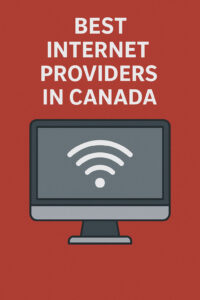Fiber vs Cable vs DSL: Which Internet Type Should You Choose in Canada?
Choosing the right internet connection in Canada can feel overwhelming, especially with the abundance of terms like fiber, cable, and DSL being thrown around. Each technology has distinct features that affect speed, cost, reliability, and accessibility. Whether you are streaming, gaming, working remotely, or simply browsing, the type of connection you choose can significantly affect your online experience. This guide will break down the differences between fiber, cable, and DSL internet so you can make an informed decision tailored to your digital lifestyle and regional availability.
Understanding the Basics of Internet Technologies
Before diving into comparisons, it is essential to understand what each internet type is and how it works. Here is a breakdown of the three primary types of residential internet connections in Canada:
- Fiber Internet: Uses fiber-optic cables to transmit data using light. It is the fastest and most reliable internet type currently available.
- Cable Internet: Operates through the same coaxial cables used for cable TV. It is widely available and delivers decent speed, especially in urban areas.
- DSL (Digital Subscriber Line): Utilizes existing telephone lines to provide internet access. It is slower compared to fiber and cable, but often more available in rural areas.
Internet Speeds: How Fast Do You Need?
Speed is often the most crucial factor for users, especially those who stream HD or 4K content, participate in video conferences, or play online games. Let us compare typical speed ranges:
- Fiber: 50 Mbps to 1.5 Gbps and beyond (symmetric download and upload speeds)
- Cable: 10 Mbps to 1 Gbps (upload speeds are usually lower)
- DSL: 5 Mbps to 100 Mbps (depends on distance from provider’s central office)
Fiber clearly leads in terms of speed and latency. With symmetrical upload and download speeds, it is ideal for content creators, streamers, and remote workers uploading large files. Cable is sufficient for most households, though upload speeds may bottleneck heavy tasks. DSL works for basic browsing and email but struggles with bandwidth-intensive applications.
Reliability and Performance Consistency
Not all internet connections perform equally well under pressure. Performance can vary based on the infrastructure, local traffic congestion, and weather conditions. Here is what you should know:
- Fiber: Extremely reliable and unaffected by electromagnetic interference. Weather has little impact, and speeds remain consistent.
- Cable: Generally reliable but can suffer slowdowns during peak usage hours when many households share the same node.
- DSL: Distance-sensitive and subject to line quality issues. Reliability varies based on the age and condition of telephone lines.
If uptime is critical, such as for remote work or online schooling, fiber is your best bet. Cable is next in line, especially in urban areas with newer infrastructure. DSL is less predictable and often used where other options are unavailable.
Availability Across Canada
Coverage varies widely between rural and urban areas. Understanding availability helps narrow down your choices:
- Fiber: Expanding across cities like Toronto, Vancouver, Calgary, and Montreal. Limited in remote and northern communities.
- Cable: Widely available in urban and suburban areas. Offered by major ISPs like Rogers, Shaw, and Videotron.
- DSL: Broadest reach, especially in small towns and rural regions where phone lines already exist.
Rural residents may be limited to DSL or satellite internet, though the Canadian government continues to invest in expanding fiber and cable infrastructure. Always check with local ISPs to verify availability at your address.
Cost Comparison: Which Option Offers the Best Value?
Internet costs vary by speed, provider, and location. Here is a general monthly pricing comparison based on 2025 Canadian data:
- Fiber: $60 to $120 per month for high-speed plans (often includes installation fees)
- Cable: $50 to $100 per month for speeds between 75 Mbps and 1 Gbps
- DSL: $30 to $60 per month for basic plans up to 50 Mbps
Fiber plans tend to be the most expensive but also deliver unmatched speed and stability. Cable offers a middle-ground option that balances speed and affordability. DSL is the cheapest, but its limitations in speed and performance may not meet modern household demands.
Pros and Cons Summary
| Technology | Pros | Cons |
|---|---|---|
| Fiber | Ultra-fast speeds Symmetrical download/upload Highly reliable |
Expensive Limited availability |
| Cable | Fast downloads Widely available Good for streaming/gaming |
Shared bandwidth Lower upload speeds |
| DSL | Low cost Available in rural areas Simple installation |
Slower speeds Distance-sensitive Outdated infrastructure |
Best Internet Type for Different Use Cases
Your ideal internet connection depends on your specific usage needs. Here are some recommendations:
- Heavy Streamers & Gamers: Fiber is ideal due to low latency and high bandwidth.
- Remote Workers & Professionals: Fiber or Cable depending on availability and upload requirements.
- Basic Browsing & Email: DSL works fine if speed is not a top priority.
- Large Households: Cable or Fiber to support multiple devices simultaneously.
- Budget-Conscious Users: DSL may suffice if price is the primary concern.
Key Providers in Canada Offering Each Type
Here is a list of major Canadian ISPs and what types of services they offer:
- Bell: Fiber, DSL
- Rogers: Cable
- Telus: Fiber, DSL
- Shaw: Cable (merging with Rogers)
- Videotron: Cable
- Xplore: DSL and fixed wireless for rural areas
- Coextro, Cannet, Diallog: Resellers offering DSL and cable at competitive rates
Future Trends in Internet Technology
The internet landscape in Canada is rapidly evolving. Here are a few trends to keep in mind:
- 5G Home Internet: Emerging as a competitor to cable and DSL in urban settings.
- Full Fiber Rollouts: Expansion of fiber infrastructure is a national priority.
- Hybrid Solutions: Providers combining fiber backbones with wireless last-mile delivery.
- Government Subsidies: Initiatives like the Universal Broadband Fund are accelerating rural access to high-speed internet.
Conclusion: Which Internet Should You Choose?
If speed, reliability, and future-proofing matter most and you live in an urban area, fiber is the clear winner. For households needing reliable service at a fair price, cable is a solid choice with wide availability. If your location limits your options or you need a basic, affordable plan, DSL still has its place. Make your decision based on your usage patterns, budget, and geographic location, and always compare local ISPs to find the best value.






